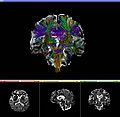Difference between revisions of "2014 Project Week:TBIdemyelination"
From NAMIC Wiki
| (One intermediate revision by the same user not shown) | |||
| Line 1: | Line 1: | ||
__NOTOC__ | __NOTOC__ | ||
<gallery> | <gallery> | ||
| − | Image:TBI-demyelination-1.jpg|[[2014_Winter_Project_Week#Projects| | + | Image:TBI-demyelination-1.jpg|[[2014_Winter_Project_Week#Projects|Lateral and superior views]] |
| − | Image:TBI-demyelination-2.jpg|[[2014_Winter_Project_Week#Projects| | + | Image:TBI-demyelination-2.jpg|[[2014_Winter_Project_Week#Projects|Anterior view with demyelination volume]] |
</gallery> | </gallery> | ||
| Line 29: | Line 29: | ||
* a Siemens Magnetom Trio Tim scanner with a magnetic field strength of 3 T was used to acquire T1- and T2-weighted magnetic resonance imaging (MRI) volumes both acutely and chronically (at several days as well as ~6 months post-injury, respectively) | * a Siemens Magnetom Trio Tim scanner with a magnetic field strength of 3 T was used to acquire T1- and T2-weighted magnetic resonance imaging (MRI) volumes both acutely and chronically (at several days as well as ~6 months post-injury, respectively) | ||
* affine co-registration of all acquired MRI volumes will be performed within each subject using 3D Slicer | * affine co-registration of all acquired MRI volumes will be performed within each subject using 3D Slicer | ||
| − | |||
| − | |||
</div> | </div> | ||
<div style="width: 27%; float: left; padding-right: 3%;"> | <div style="width: 27%; float: left; padding-right: 3%;"> | ||
<h3>Progress</h3> | <h3>Progress</h3> | ||
| − | * | + | * the extent of axonal demyelination was estimated based on the ratio of voxel intensities between T1 and T2 volumes following the methodology of Glasser & Van Essen (Journal of Neuroscience, 2011, vol. 31, p. 11597). |
| + | * myelin content measurements were discarded from the analysis for brain regions which exhibit pathology-related alterations in voxel intensity due to the presence of acute trauma, resulting in an analysis of healthy-appearing brain regions only. | ||
| + | * with the help of 3D Slicer, we have identified considerable demyelination of axons throughout both white and gray matter | ||
| + | * regions with considerable demyelination include the corpus callosum and peri-ventricular areas, as well as the insula and temporal cortex | ||
| + | * these results are encouraging, and the next step will be to use 3D Slicer in order to determine which WM connections are most affected by demyelination after TBI | ||
</div> | </div> | ||
</div> | </div> | ||
Latest revision as of 05:56, 10 January 2014
Home < 2014 Project Week:TBIdemyelinationKey Investigators
Andrei Irimia, PhD (Institute for Neuroimaging and Informatics, University of Southern California)
SY Matthew Goh, BS (Institute for Neuroimaging and Informatics, University of Southern California)
Carinna M. Torgerson, BS (Institute for Neuroimaging and Informatics, University of Southern California)
John D. Van Horn, PhD (Institute for Neuroimaging and Informatics, University of Southern California)
Project Description
Objective
- To determine the extent and location of axonal demyelination in the gray matter and white matter of the brain for a group of TBI patients
- We seek to understand how mapping demyelination in TBI may help to elucidate the relationship between neuropsychological deficits and structural brain changes due to this condition, with potential relevance to personalized treatment and rehabilitation.
Approach, Plan
- the study will be implemented in accordance with the Declaration of Helsinki and with approval from the UCLA and USC Institutional Review Boards
- multimodal neuroimaging data acquired from patients admitted to the Neurointensive Care Unit of the UCLA Ronald Reagan Medical Center will be used
- a Siemens Magnetom Trio Tim scanner with a magnetic field strength of 3 T was used to acquire T1- and T2-weighted magnetic resonance imaging (MRI) volumes both acutely and chronically (at several days as well as ~6 months post-injury, respectively)
- affine co-registration of all acquired MRI volumes will be performed within each subject using 3D Slicer
Progress
- the extent of axonal demyelination was estimated based on the ratio of voxel intensities between T1 and T2 volumes following the methodology of Glasser & Van Essen (Journal of Neuroscience, 2011, vol. 31, p. 11597).
- myelin content measurements were discarded from the analysis for brain regions which exhibit pathology-related alterations in voxel intensity due to the presence of acute trauma, resulting in an analysis of healthy-appearing brain regions only.
- with the help of 3D Slicer, we have identified considerable demyelination of axons throughout both white and gray matter
- regions with considerable demyelination include the corpus callosum and peri-ventricular areas, as well as the insula and temporal cortex
- these results are encouraging, and the next step will be to use 3D Slicer in order to determine which WM connections are most affected by demyelination after TBI

